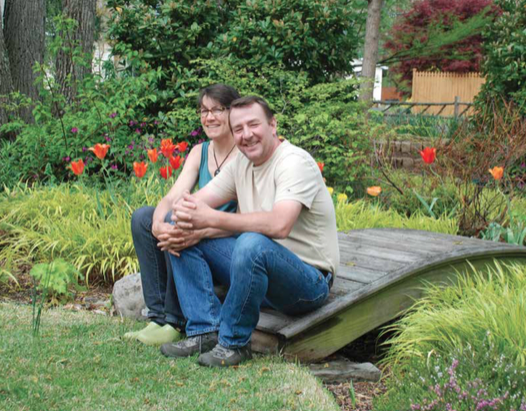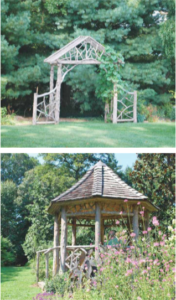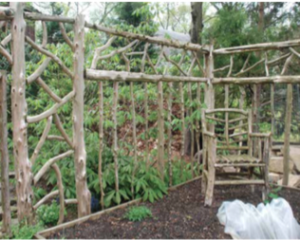French follies for the garden

Nancy and Pierre Moitrier rest for a moment on a wooden bridge built across a small ditch on their property in Annapolis, Md. Both landscape designers, the couple own and operate Designs for Greener Gardens Inc. Pierre enjoys creating “French Follies,” one-of-a-kind whimsical structures that provide delight in a garden.
In 1998, Nancy Lowry, daughter of Jack and Jean Lowry of Lowry & Company in Phoenix, Md., went to London to study garden structure to augment her career in horticulture and landscape design. There were not many opportunities to learn about garden structures in America.
As she was studying the English gardening style, she met Pierre Moitrier, a native of France.
“It was a totally random meeting,” he said. “She brought back a guy who would do rockscape — that’s smarter than learning it,” he quipped.
“I think he likes it,” she interjects.
Now married, together they operate Designs for Greener Gardens, Inc., in Annapolis, Md., and their home garden filled with plants serves as a sort of test plot.
The corner lot is dominated by a huge treehouse, which has been featured in a Treehouse Masters book.
Pierre bought a book in France that had a treehouse in it, and he decided he would build one.
The platform went up in 2004. Two or three years later, the rest of the treehouse was added, with provision for growth of the tree, but some maintenance is necessary.
Now weathered, with moss growing on the wooden roof shingles, the treehouse looks as though the tree started growing under it and just lifted it up in the air as it matured, stretching its limbs through the sides of the building.
“This was my first and only treehouse,” Pierre said. “Although I’ve had other requests. I built this one for me. It was a childhood dream. It serves more as a piece of sculpture in the garden.”
Nancy added, “It is fun to look at. Now it is a piece of whimsy in the garden.”
Pierre has created other pieces of what they call “French Follies.”
These whimsical creations are one-of-a-kind structures of rustic patios, walkways, walls, fences, gates, bridges, trellises and pergolas.
The ultimate goal of a folly is to provide delight.

One of Pierre Moitrier’s favorite works of whimsy is a lychgate, top, a roofed gateway entrance to a garden, like a little foyer. “It’s like a gazebo, but you go through it,” Pierre said. “It serves as a welcoming mat for the garden.” For this gazebo, bottom, and other follies, he found inspiration in a New York state park and at Yellowstone National Park where natural timbers were used in construction.
(Photos courtesy Designs for Greener Gardens)
One of his favorites is a lychgate, a roofed gateway entrance to a garden, like a little foyer.
“It’s like a gazebo, but you go through it,” Pierre explained. “It serves as a welcoming mat for the garden. It can have a bench. The ceiling can be solid or one you can grow a vine like wisteria on.”
Their home vegetable garden, measuring 25 feet by 25 feet, is surrounded by a folly fence made of rough cedar.
Pierre got the idea while he and Nancy were working on a design for a couple in Baltimore County who wanted a huge vegetable garden.
Nancy suggested an enclosure, because the deer were going to feast on anything they tried to grow. The client agreed, but what kind of fence? The client also had many red cedar trees growing wild on his property. He didn’t know what they were, but he didn’t like them. Get rid of them, he instructed.
Pierre recalled scenes in a New York state park and at Yellowstone National Park where natural timbers were used in construction. “I was taken away with them when I first saw them on our honeymoon in 2002. I saw the lodge, how the trees were used in rough form. I found it beautiful. The logs were not square and perfect. Every bump and distortion was celebrated,” he said. “I knew I could not only do something functional but beautiful.”
He had had the idea before, but this was the first time he was permitted to try it on the job.
“I built a big fence, and it had done great. It kept the deer at bay. They grew a wonderful vegetable garden,” he said.
He built another fence for their own garden in 2004.
He had 100 trees of various sizes, all Eastern red cedar, Juniperus virginiana.
“I really like working with this wood,” he said. “It is rot resistant and insect resistant. The wood has a lifespan of 15 years without being treated.
“It’s beautiful. I use it with the bark, and as it ages, the bark dries and peels off . The squirrels and birds use it. It is bleached by the sun, turning grey or golden.
“It’s amazing that you can use all parts of the tree — the thickest for posts, the thinnest limbs for rails. The tops of the trees make pickets.”
At the top of the fence he used a technique he calls “webbing,” using branches to bring a dimension of something artistic.
“It’s a wonderful plant to use at different stages of life. You can just use all of it,” he exclaimed.
He added, “If you’re really good, you can even make gin. I don’t.”
Pierre said he draws inspiration from nature, his travels and the charm of old villages in France.
He had no formal training; he just learned by doing and learned from his bride.
For the last three years, he has been studying landscape design at George Washington University. The last class for his landscape design certification ended May 10.

Pierre Moitrier, landscape designer in Annapolis, Md., created this folly fence of rough red cedar to enclose the vegetable garden on the couple’s property. He uses all parts of a cedar tree in his designs.
(Photo courtesy Designs for Greener Gardens)
Nancy’s father was a representative for several nurseries and over the last 50 years has brought home many unusual specimens for his own “horticultural zoo.”
Her mother is one of the few people in the United States, and the only Marylander, who has twice taken all the courses required to earn the National Council of Garden Clubs’ Gold Star.
She is a flower show judge, landscape design consultant, gardening consultant and environmental studies consultant.
Having grown up in this world of plants, perhaps it was inevitable that Nancy earned a degree in horticulture from Penn State University.
She has honed her skills at various garden centers and at the U.S. National Arboretum.
She is an APLD Certified Garden Designer, Certified Horticulturist, Internationally Certified Arborist, licensed Maryland Tree Expert and licensed Pesticide Applicator.
Their website, www.greenergardens.net, has photos of some of their landscape designs and French follies, including a stone couch and a “Ruin Garden Labyrinth.”
Perhaps some of the pictures will inspire you.
To contact Designs for Greener Gardens, call 410-626-6122.



